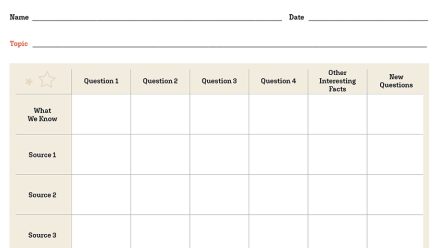Download a Graphic Organizer
The Inquiry Chart (I-Chart) is a strategy that enables students to generate meaningful questions about a topic and organize their writing. Students integrate prior knowledge or thoughts about the topic with additional information found in several sources. The I-Chart procedure is organized into three phases: (1) Planning, (2) Interacting, and (3) Integrating/Evaluating. Each phase consists of activities designed to engage students in evaluating a topic.
Why use an I-Chart?
I-Charts foster critical thinking and strengthens students’ reading skills. I-Charts can be used with the entire class, small groups, or with individual students. You’ll love them because they can easily be differentiated and provide a low-key evaluation of how much your students have learned about a topic.
How to create and use the strategy
- Download our I-Chart template (fillable pdf) for students to use. You can scaffold the strategy by prefilling some of the organizer for particular students.
- Help students begin with the planning phase by identifying the topic, forming questions (are placed at the top of each individual column), and collecting materials
- The next step is to engage students in the interacting phase which involves students recording any information students already know and reading and pulling key ideas from several different sources of information, and sharing interesting facts with partners or within small groups.
-
Finally, guide students through the integrating and evaluation phase. The last row gives students the opportunity to pull together their ideas into a general summary. Students will use their summarizing, comparative analysis, critical thinking, and research and reporting skills as they resolve competing ideas found in separate sources or develop new questions to explore based on any conflicting or incomplete information.
Strategy in action
Image what it would look like for a whole school to take an inquiry-based approach to learning. Wildwood IB World Magnet School uses the inquiry-based model to put students in charge of their learning, with lessons that stem from student questions and harness the power of curiosity.
Tips for success
- Encourage students to continue to add new questions as they learn more, so they can delve deeper into a topic.
- I-Charts can help organize students’ knowledge about a topic for writing an essay or class presentation.
